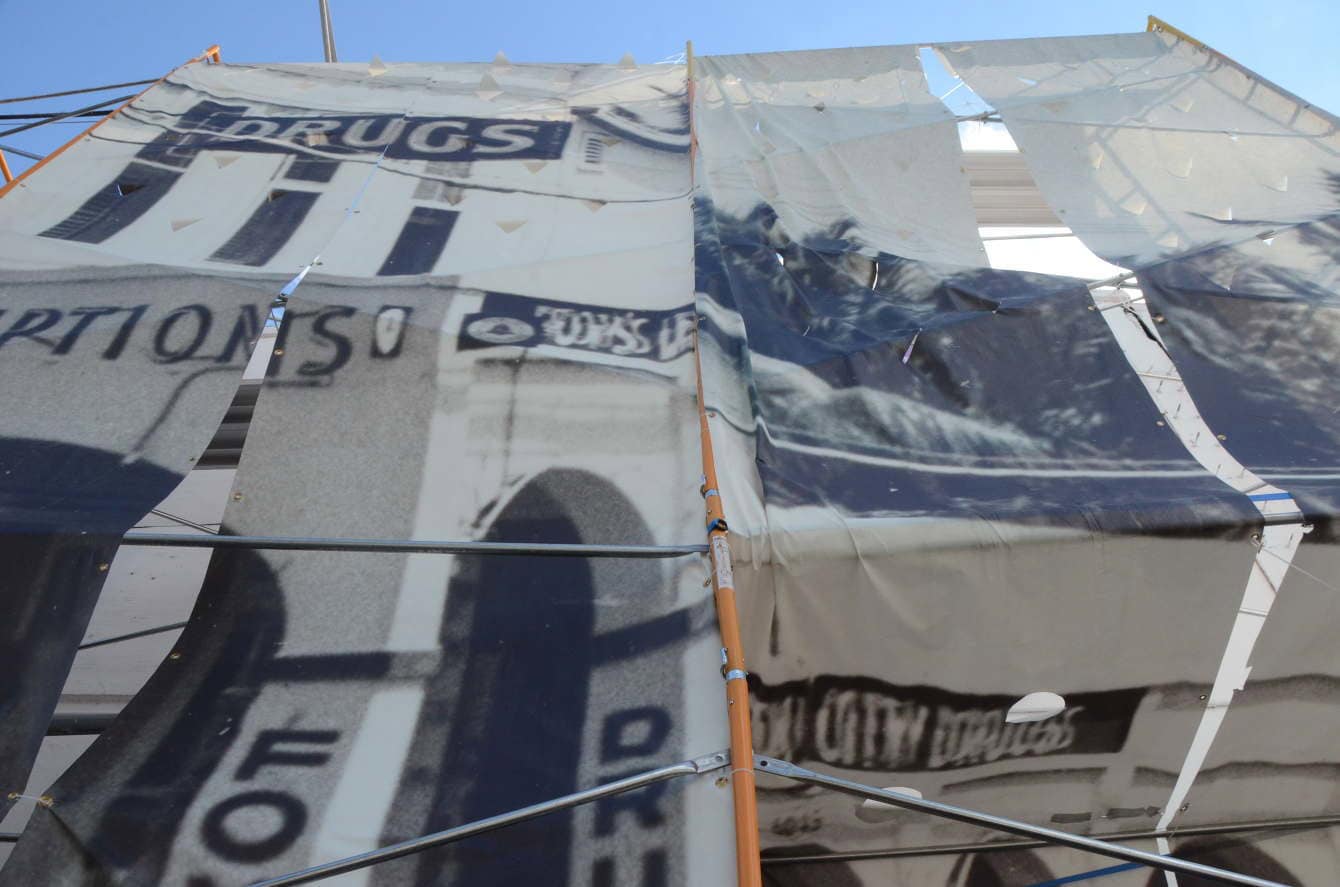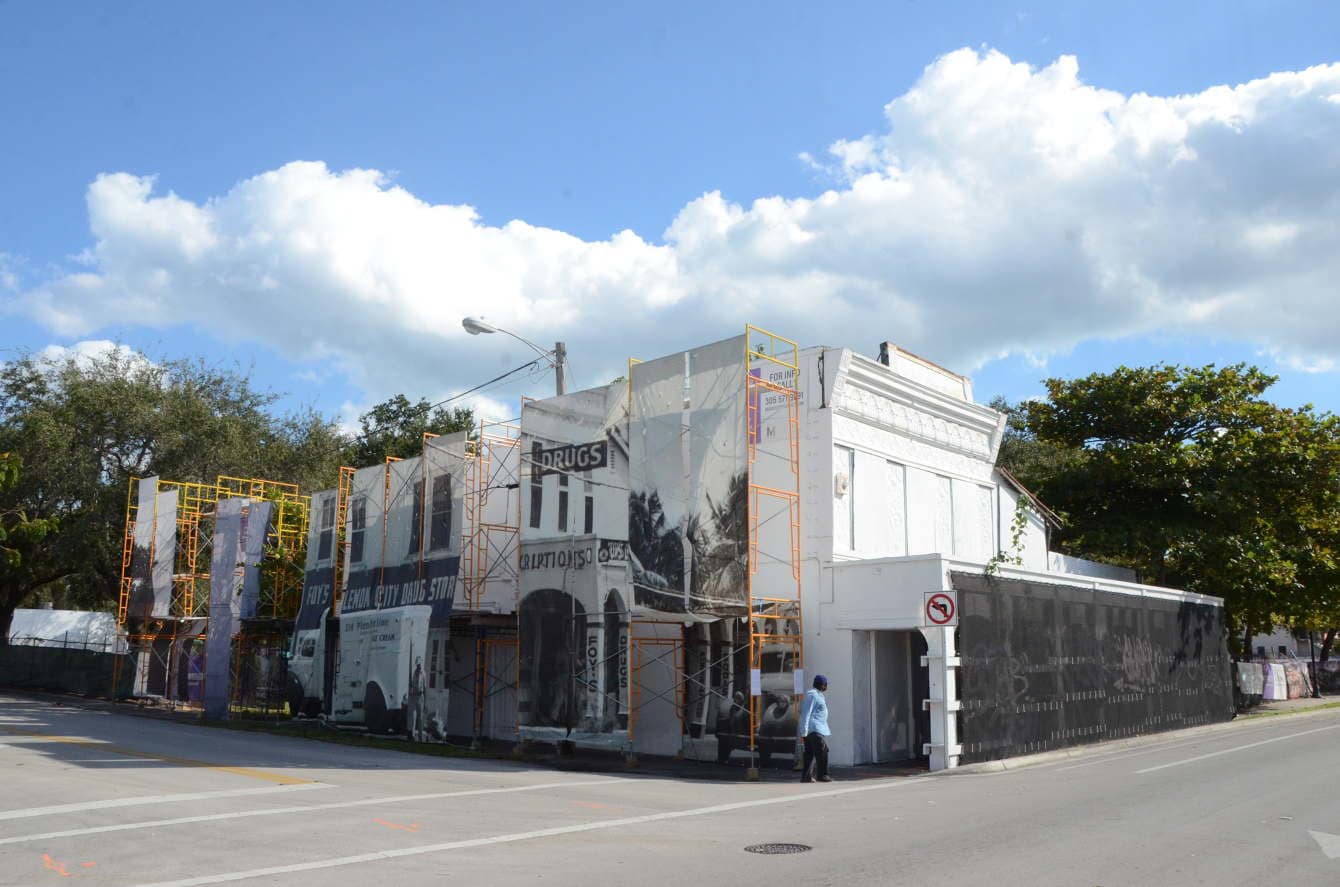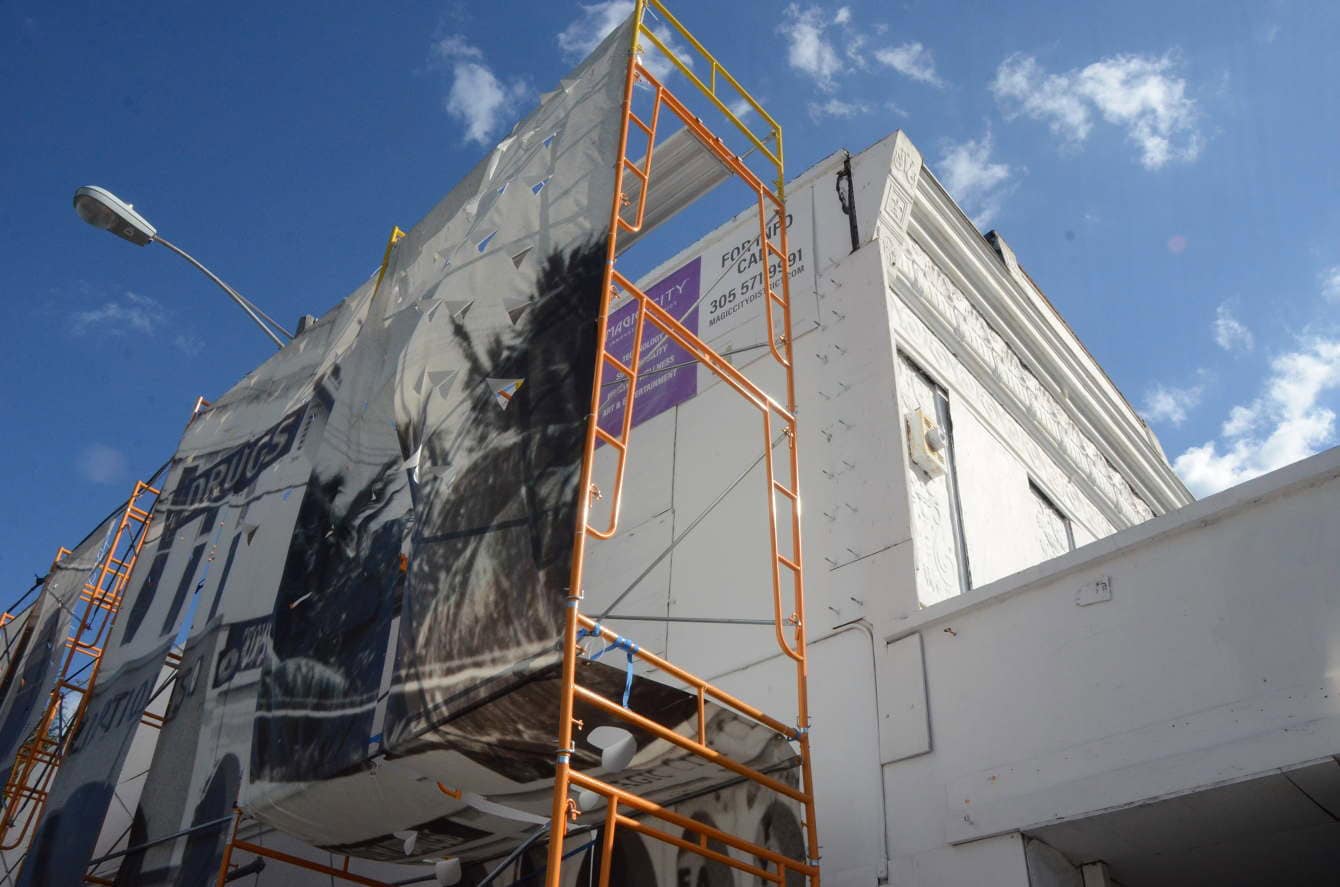
Gentrification and the ensuing displacement it advances are nearly ubiquitous phenomena in cities all over the world. Cities change, capital either floods or seeps into new geographies, and people are left to figure out where they fit in. Of course these changes are not neutral events but rather the result of power slyly moving between public and private channels, always informed by external factors. In Miami, some of these affecting agents are the tourism industry, the storage of wealth in real estate properties, and, most recently, the climate crisis. The infamous signs of gentrification—art galleries, coffee shops, the juxtaposition of demolished and prefab buildings standing side by side—often signal change before it has fully taken root. The literal signs of real estate developers, however, which advertise shiny architectural renderings before they’ve been built, are perhaps the most suspect of these cues because they visualize a speculative future. These images neglect history and the present to shape a neighborhood in favor of a future that is unclear in terms of who it will benefit. Artists Misael Soto and Ayesha Singh utilize this polarizing advertising form in their ongoing project Provisional Obstruction to make temporary visual interventions in the use of images to manipulate a neighborhood’s appearance and accelerate change.
Provisional Obstruction is an ongoing collaboration between Soto and Singh that began in Chicago in 2017. The duo erected scaffolding outside of ACRE Projects, a new art gallery in the rapidly changing neighborhood of Pilsen. A photograph replicating the gallery’s facade—proportionally and in high resolution—was printed on a scrim-like material and installed on the street-facing side of the scaffolding. The project highlighted the presence of an old funeral home that is now inhabited by an art gallery, a shift in purpose and audience not often made visible on the street, aside from the different people walking through the building’s doors. Using the advertising tools of real estate development, Soto and Singh marked neighborhood change as it was happening in real time. Importantly, they also thought reflexively enough to represent art’s complicity in, and sometimes even encouragement of, gentrification.

In Miami, Provisional Obstruction is hosted by the Bas Fisher Invitational and takes on a similar form while responding specifically to Little Haiti, where it is installed. A historically Haitian and Caribbean immigrant community since the 1980s, Little Haiti happens to be, at ten feet above sea level, one of the most elevated neighborhoods in Miami. The city’s swampy, low lying topography has made Miami subject to even the slightest rise in sea level shifts, which have only become more frequent as storms fueled by climate change continue to arrive each year. Aside from severe water damage and inconvenience, the effects of sea-level rise have cultivated a new practice called “climate gentrification” in which real estate developers have begun aggressively moving inland to purchase properties situated at higher ground. This practice functions in direct opposition to the historical pattern of developers gravitating toward Miami’s wealthier waterfront neighborhoods. For many lower income residents of Little Haiti, this sudden shift feels alarming and disarming. Many longtime residents have been insistently approached by investors wanting to buy them out at prices exponentially higher than what they initially paid for their properties. Because of the Little Haiti’s desirable elevation and proximity to Biscayne Bay, Wynwood, and the Design District, in recent years it has drawn significant attention from large real estate developers and become a focal point of battles over climate gentrification in Miami.
Soto and Singh have situated this iteration of Provisional Obstruction at the shuttered Lemon City Pharmacy, a historic building in the neighborhood that has become a symbol of Little Haiti’s identity and past. The building’s location at the corner of 2nd Avenue and 61st Street is also an anchor point of transformation in the impending Magic City Innovation District, which describes itself as a pleasant and positive force: “Over the last four years, we have helped Little Haiti and Little River become more desirable and recognizable neighborhoods in Miami attracting artists, creatives, entrepreneurs and makers to our community.” Tired marketing language like this has been used since Richard Florida’s now much derided introduction of the notion of the “creative class” nearly twenty years ago, implementing a framework that rapidly gentrified cities across the U.S. through the masquerade of supporting art and cultural production. According to Florida’s framework, supporting the creative class is meant to revitalize cities but, as artist Martha Rosler has pointed out, “[Richard] Florida may see this class, and its needs and choices, as the savior of cities, but he harbors no apparent interest in its potential for human liberation” [1]. The same is true for the one-billion-dollar Magic City development that received commissioner approval this past summer, despite extensive protests from wary activists and community groups who believe the eighteen-acre project does not serve public interests and will inevitably cause a massive displacement of the historically significant population of the neighborhood. Little Haiti only received official neighborhood designation in 2016 after a decade of local activism, and this development threatens to complicate that legacy.
The nearly simultaneous recognition of the neighborhood and its expected whitewashing create a strange contradiction between recognition and erasure. Provisional Obstruction approaches this contradiction formally by juxtaposing images of the Lemon City Pharmacy façade at different moments in time. The current Magic City advertising is replicated and repositioned next to an archival photograph of the pharmacy from the 1950s, when it was bustling with local activity and commerce. Printed on large sections of woven material and mounted to the scaffolding, the installation abstracts these images through a collage-like arrangement stretched over ninety feet wide. Like the previous Chicago iteration of the project, this current version mimics the present state of the building—erased of previous use and plastered with Magic City Innovation District advertisements—yet also adds photographs that look backwards. The typical aesthetic of forward-looking neoliberal utopianism is inverted, a gesture which confidently contends that such aesthetics are not neutral visions of the future. Soto and Singh’s installation questions how the signs of gentrification and development function and challenge the flattened idealism these images are meant to substantiate. Provisional Obstruction reorients that idealism to represent a separate set of desires and politics that choose to look backwards rather than forward. The installation demonstrates that progress does not move forward unilaterally but is always dependent upon the orientation of who is imagining a future and to what ends.

At the opening reception for the project, multiple neighbors approached and asked if the gathering was another protest against Magic City. Soto responded to these folks by situating the project as a conversation starter and opportunity to reflect, rather than representing a clear set of political motivations. These efforts toward complexity are admirable, but it remains unclear what they ultimately represent or if they are simply too little too late given the development has already been green-lighted. Further complicating the critical capacity of the project is the fact it received approval from developers to use the Lemon City Pharmacy building. This sanctioning of the work obscures its position even more so. Any of the artists’ intentions to slow the development’s implementation may simply be absorbed into Magic City’s efforts to assuage public derision and bolster their reputation as cultural supporters in Little Haiti, all while simultaneously displacing the current population.
These realities are not a failure on the part of Soto and Singh. Both artists are cognizant of the factors in producing a work that is meant to link so many constituents—artists, developers, and communities—in a conversation on public art and culture that moves beyond the flashy street art of neighboring Wynwood. On view during the annual frenzy of Art Week, the installation brings to light the perpetually unresolved relationships between art and urban development, and to the often contradictory nature cultural production has for the communities it is meant to benefit.
Provisional Obstruction, an installation by Ayesha Singh and Misael Soto presented by Bas Fisher International, is on view at 6041 NE 2nd Avenue in Miami through December 15.
[1] Martha Rosler, “Culture Class: Art, Creativity, Urbanism, Part II,” e-flux Journal 23, March 2011.




